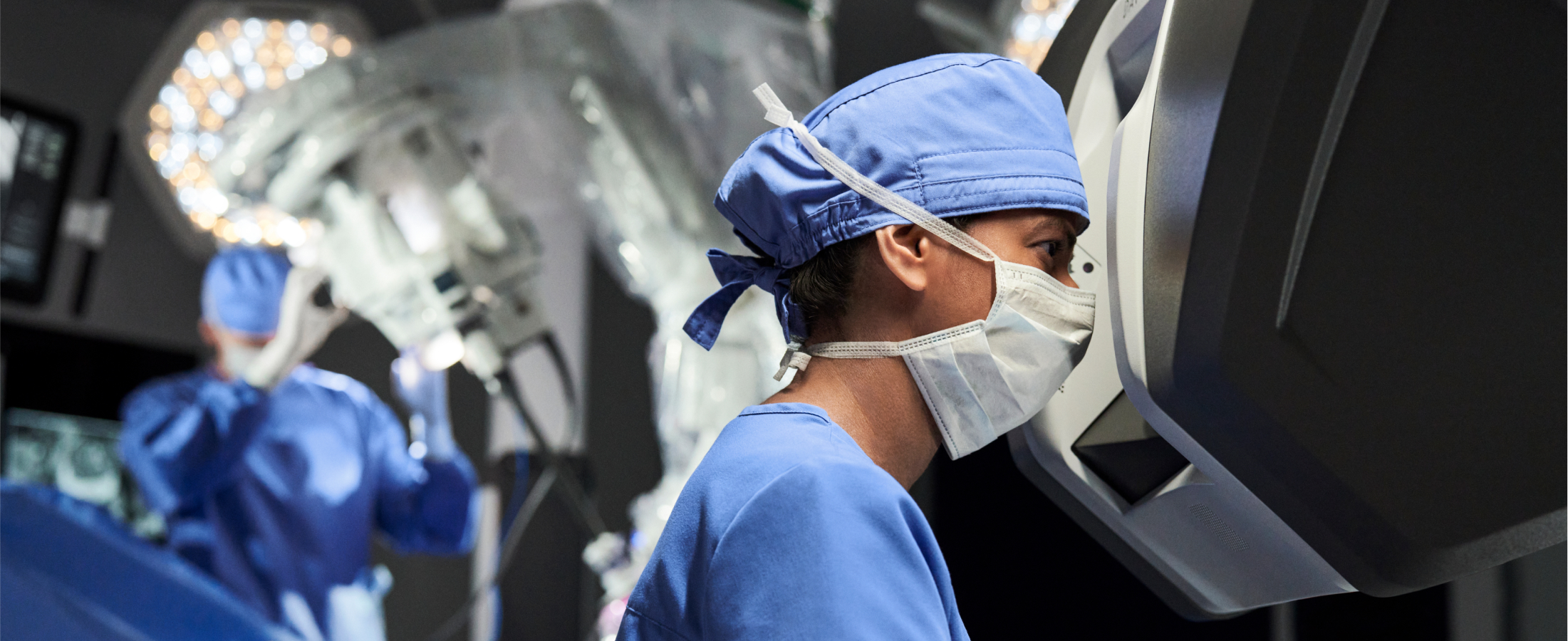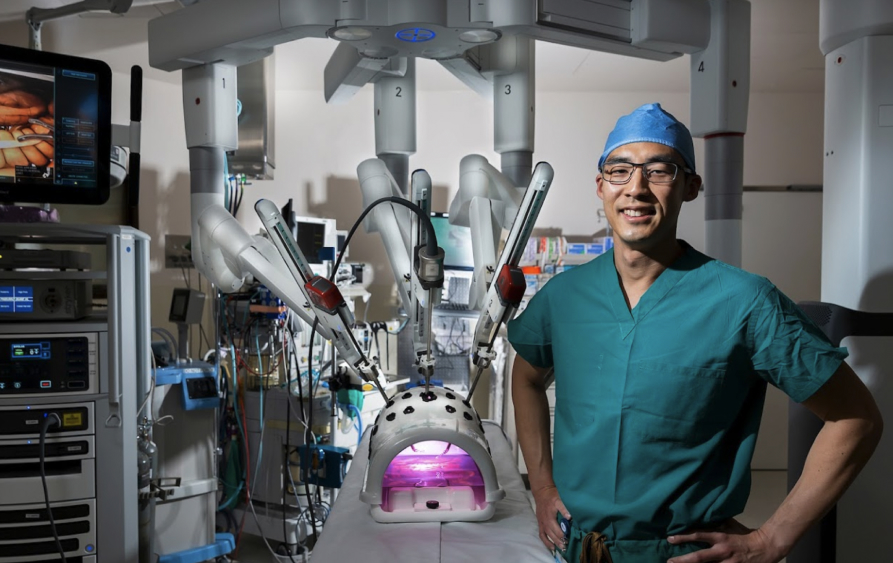

When Dr. Rockson Liu performs surgery with the Intuitive da Vinci system, he often loses himself in the moment, to the point that he almost feels as if there were no separation between him and the patient. Liu, a private-practice general surgeon with a thriving robotic surgical practice in the San Francisco area, compares the feeling to the “flow state” an athlete can experience during play, the sense of knowing exactly what to do, and how to do it.
Central to this experience, Liu says, is the immersive surgeon console of the da Vinci surgical system. The console, one of three elements that make up the system, is the means through which Liu and other da Vinci surgeons perceive and interact with the patient during the procedure. It enables the surgeon to see inside the patient’s body with impressive detail and clarity, access a wide range of procedure-related information such as patient vital signs, and precisely control the wristed instruments and endoscope on the four robotic arms on the patient cart.
“I tell patients it’s like shrinking myself down so that I’m small enough to be moving around in the body,” says Liu, who has been performing minimally invasive surgery for almost two decades. “When I’m operating with the da Vinci, the console gives me the sense that I’m actually inside the patient's body as I'm doing surgery. It's almost like my hands are in there working.”
At Intuitive, that precision is the goal. For nearly three decades, the company has continuously innovated its technology to ensure that its console allows surgeons to stay fully absorbed in the procedure. “That’s how we’ve designed every aspect of the console,” says Mark Palmer, Intuitive’s senior manager of industrial design.
The da Vinci system employs a head-in stereo console, meaning that the surgeon has a separate display for each eye. According to Pushkar Hingwe, Intuitive’s senior director of new product development, this setup allows surgeons to see with binocular vision. Having an individual viewer for each eye replicates the way the human brain organizes vision and interprets visual data, and can be crucial for giving users a view of surgery that is both high-definition and fully three-dimensional.
“Each eye has its own display,” Hingwe says. “They are completely separate. So the brain doesn't get confused.” The result, says Liu, is that during a da Vinci procedure, they see the patient’s anatomy with exceptional clarity and vividness.
Moreover, there is almost no latency in the system; in other words, the surgeon receives visual information through the system almost instantaneously. The entire process—from the light hitting the camera sensor to the surgeon seeing the scene in the viewfinder—takes less than 16 milliseconds (a typical eye blink takes 100-150 milliseconds). During this time, the image goes through more than ten separate processing steps, while the image is refreshed 60 times a second.
The head-in approach contrasts with another design solution, often referred to as an “open” console, which features external screens that aren't able to customize visuals for each eye. Over the years, Hingwe says, Intuitive has experimented extensively with this approach, and found that it provides less clarity and three-dimensionality. And because each eye shares the same view of a flat screen, the approach can trigger confusion between the eyes and the brain, which may lead to increased eye fatigue, headaches, and dizziness, all of which can add to the surgeon’s cognitive load.
David Robinson, Intuitive’s vice president for multiport design engineering, points out that Intuitive’s head-in console design maximizes surgeon comfort during the hours they spend performing a procedure. “It has to feel comfortable,” says Robinson. “And it has to fit a variety of face shapes and sizes—including glasses. It’s something we’ve thought about very deliberately.”
Another advantage of Intuitive’s head-in console is the ability to control lighting. In this approach, there is a low risk that ambient or reflected light will leak in and affect the surgeon’s view. Screens, by contrast, are subject to whatever lighting exists in the OR; this variation could potentially affect the surgeon’s view and increase eye fatigue.
Yet another approach for surgeon vision is to relay visual data through a set of AR/VR goggles or glasses. Intuitive has also evaluated this approach extensively and has found that in its current form, it’s subject to many of the same problems as the open console.
Intuitive engineers and designers have focused not only on the console’s performance, but on its comfort. Liu, who has performed more than 1,100 cases using the da Vinci system, says that in his experience, using the console puts significantly less stress on his body than either open or laparoscopic procedures, where a surgeon must stand next to the patient to manipulate surgical instruments instead of sitting at a da Vinci console. “It's just physically exhausting to stand there and do surgery,” he says.
The console also features a built-in microphone, which allows surgeons to communicate easily with OR staff. And if the surgeon does pull out of the display, the system arms lock in place for patient safety.
To further advance surgeon ergonomics, Intuitive engineers are working on solutions that will allow users to make more adjustments to the headset orientation, so that they can perform procedures from a wider range of postures and positions.
Another subtle but important innovation with the da Vinci console is the distance between the system’s endoscopic camera and the patient’s anatomy. After considerable experimentation, Intuitive engineers concluded that the optimal length was a little less than 400 millimeters, roughly 18 inches.
“If you’re at a desk and you're working on, say, a crafts project, trying to put something together, glue things together, use a screwdriver, that generally feels like the most comfortable distance,” Hingwe says. “We’re mimicking that experience.” It is much harder to consistently achieve this sense of the ideal working viewpoint with an open console, he says.

A central facet of the immersive experience is visual clarity, especially color. Intuitive engineers have focused particularly on displaying a range of subtle variations along the red wavelength. “Generally, human tissue has many shades of red,” Hingwe says. “So that’s crucial. That’s our goal, to render tissue color with at least the same clarity and subtlety as what the human eye can.” Intuitive engineers are working to expand the range of red so that surgeons can see an even broader spectrum of hues and tones.
Another key aspect of Intuitive’s approach to the visual experience is quantum dot technology. This method uses a film of extremely small crystals, each only a few atoms across, to display a wide range of subtle color variations. Hingwe and his colleagues are developing an even more advanced version of the technology, further improving the surgeon’s visual experience.
The console also provides surgeons with easy access to a range of crucial clinical information, including energy settings and tissue thickness during stapler firing. Liu says having this data at his fingertips helps keep him on top of the many variables he must track over the course of a procedure.
At the same time, Intuitive is careful not to inundate surgeons with unnecessary detail. “It’s something we're constantly aware of,” says Palmer. “We want to help surgeons stay focused on the surgery. So we’re very mindful about not overloading them with distracting information.”
Hingwe, who has worked at Intuitive for 15 years, says he encourages his team to continually think big when it comes to optimizing the surgeon’s experience. “I tell my team all the time, ‘Let’s do something so extraordinary that it seems magical,’” he says. “To me, it’s about enabling surgeons to do exactly what they intend to do, without having to think about it. And I think we accomplish that.”
Financial disclosure
The independent healthcare professional quoted on this website has received compensation from Intuitive for consulting and/or educational services. The material presented represents the views, experiences, and opinions of independent surgeons based on their practice and personal experience performing surgery with the da Vinci surgical system. Their experience may or may not be reproducible and is not generalizable.
Important safety information
Serious complications may occur in any surgery, including surgery with a da Vinci system, up to and including death. Examples of serious or life-threatening complications, which may require prolonged and/or unexpected hospitalization and/or reoperation, include but are not limited to, one or more of the following: injury to tissues/organs, bleeding, infection, and internal scarring that can cause long-lasting dysfunction/pain.
Risks specific to minimally invasive surgery, including surgery with a da Vinci system, include but are not limited to, one or more of the following: temporary pain/nerve injury associated with positioning; a longer operative time, the need to convert to an open approach, or the need for additional or larger incision sites. Converting the procedure could result in a longer operative time, a longer time under anesthesia, and could lead to increased complications. Contraindications applicable to the use of conventional endoscopic instruments also apply to the use of all da Vinci instruments.
For important safety information, including surgical risks and considerations, please also refer to www.intuitive.com/safety. For a product’s intended use and/or indications for use, risks, full cautions and warnings, please refer to the associated user manual(s).
Individual outcomes may depend on a number of factors, including but not limited to patient characteristics, disease characteristics, and/or surgeon experience.
Da Vinci Xi/X system
The demonstration of safety and effectiveness for the representative-specific procedures did not include evaluation of outcomes related to the treatment of cancer (overall survival, disease-free survival, local recurrence) or treatment of the patient’s underlying disease/condition. Device usage in all surgical procedures should be guided by the clinical judgment of an adequately trained surgeon.
Da Vinci instruments and accessories
It is the responsibility of the owner of the da Vinci surgical system to properly train and supervise its personnel to ensure that the instruments and accessories are properly cleaned, disinfected, and sterilized as required by the user’s manual. Da Vinci products should not be used in a clinical setting unless the institution has verified that these products are properly processed in accordance with the da Vinci system user manual.